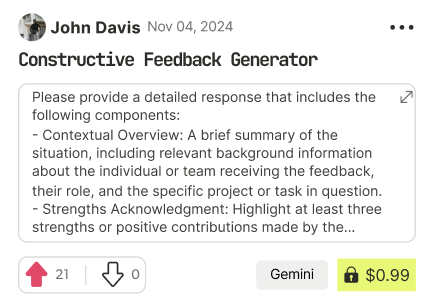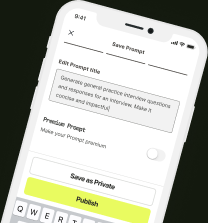prompt mine App
Find, Create & Share AI Magic
Comprehensive Creative Block-Breaking System
This system, grounded in cognitive science and creative practice research, provides a structured approach to diagnose and overcome creative blocks. It encompasses diagnostic protocols, targeted techniques, environmental adjustments, confidence-building exercises, and a 7-day restoration program tailored for various creative disciplines.
Diagnosing Creative Blocks
Understanding the type of block is crucial for effective intervention. Here are diagnostic protocols for common creative blocks:
1. Perfectionism Block:
Symptoms: Procrastination due to fear of not meeting self-imposed high standards, excessive self-criticism during the creative process, constant revision without completion, feeling paralyzed by the need for flawless execution.
Diagnostic Questions:
Do you frequently restart projects or abandon them due to perceived imperfections?
Are you more focused on avoiding mistakes than enjoying the creative process?
Do you feel anxious about sharing your work because it might not be "good enough"?
Is your internal critic overly harsh and discouraging?
Do you struggle to declare a project "finished"?
2. Uncertainty Block:
Symptoms: Lack of direction or purpose in creative work, feeling lost about what to create next, questioning the value or relevance of your creative output, fear of failure stemming from not knowing the "right" path.
Diagnostic Questions:
Do you feel unsure about your creative direction or goals?
Are you struggling to identify what you want to express or explore creatively?
Do you question the point of your creative endeavors?
Are you hesitant to start projects because you lack a clear plan or outcome?
Do you feel envious of others' seemingly clear creative paths?
3. Overwhelm Block:
Symptoms: Feeling mentally overloaded with ideas, information, or responsibilities related to creative work, difficulty prioritizing tasks, feeling scattered and unable to focus, avoidance of creative tasks due to mental exhaustion.
Diagnostic Questions:
Do you have too many creative ideas and don't know where to start?
Are you juggling multiple projects or responsibilities that are draining your creative energy?
Do you feel mentally exhausted and unable to focus on creative tasks?
Is your creative process disorganized and chaotic, adding to your stress?
Do you avoid creative work because it feels like another burden?
4. Motivation Block:
Symptoms: Lack of enthusiasm or drive to engage in creative activities, feeling apathetic towards creative projects, difficulty initiating or sustaining creative work, perceiving creative tasks as chores rather than enjoyable pursuits.
Diagnostic Questions:
Do you feel a general lack of interest in your usual creative outlets?
Are you finding it difficult to initiate or maintain momentum on creative projects?
Do creative tasks feel like obligations rather than sources of enjoyment?
Are you experiencing a decline in your intrinsic motivation for creative work?
Do you procrastinate on creative tasks even when you have the time?
Specialized Techniques for Overcoming Block Types
1. Perfectionism Techniques:
Embrace Imperfection: Consciously create "imperfect" works (e.g., timed sketches, messy drafts). Focus on process over perfect product.
Set "Good Enough" Goals: Define realistic standards for each project stage, prioritizing completion over flawlessness.
Timeboxing & Deadlines: Impose strict time limits to force completion and reduce overthinking.
Positive Self-Talk: Replace self-critical thoughts with encouraging affirmations. Focus on progress, not perfection.
Seek Constructive Feedback Early: Share work-in-progress to gain perspective and reduce the pressure of solitary perfectionism.
2. Uncertainty Techniques:
Exploration & Experimentation: Engage in freeform exploration without specific goals (e.g., mind mapping, brainstorming, playing with new materials).
Define Core Values & Interests: Reconnect with your fundamental creative drivers. Journal about what excites and inspires you.
Small, Defined Projects: Break down large, daunting ideas into smaller, manageable tasks with clear objectives.
Seek Inspiration from Diverse Sources: Expose yourself to new art forms, genres, and experiences to spark fresh ideas.
"What If" Questions: Use playful "what if" scenarios to generate novel creative directions and challenge assumptions.
3. Overwhelm Techniques:
Prioritization & Task Breakdown: Use tools like Eisenhower Matrix (urgent/important) to prioritize tasks. Break down large projects into smaller, actionable steps.
Mindfulness & Meditation: Practice mindfulness to reduce mental clutter and improve focus. Short meditation sessions can calm the overwhelmed mind.
Time Management & Scheduling: Allocate specific time blocks for creative work and stick to them. Use time-blocking techniques to structure creative sessions.
Delegation (if applicable): If possible, delegate non-essential tasks to free up mental space for creative work.
"Brain Dump" Journaling: Write down all thoughts and ideas to clear your mind and gain a sense of control.
4. Motivation Techniques:
Reward System: Set small, achievable goals and reward yourself upon completion. This reinforces positive associations with creative work.
Connect with Creative Community: Engage with other creatives for inspiration, support, and accountability. Join online forums, workshops, or local groups.
Change of Creative Environment: Work in a different location or setting to break routine and stimulate new perspectives.
Explore New Creative Modalities: Experiment with a different art form or medium to rekindle excitement and discover hidden interests.
Find Your "Why": Reconnect with your intrinsic motivations for creating. Reflect on the personal meaning and purpose of your creative work.
Environmental Modifications to Stimulate Creative Flow
Dedicated Creative Space: Designate a specific area solely for creative work. This helps mentally signal "creative time" when you enter the space.
Minimize Distractions: Reduce noise, visual clutter, and digital interruptions in your creative space. Use noise-canceling headphones or website blockers if needed.
Nature Integration: Incorporate natural elements like plants, natural light, or views of nature into your workspace. Nature has been shown to boost creativity and reduce stress.
Sensory Stimulation: Experiment with ambient sounds, scents (essential oils like rosemary or citrus), or textures that enhance focus and mood.
Organized Workspace: A clean and organized workspace can reduce mental clutter and promote a sense of calm and control.
Progressive Exercises for Rebuilding Creative Confidence
Phase 1: Re-engagement (Days 1-2)
5-Minute Freewriting/Sketching: Daily, no-pressure exercises to simply re-engage with the creative process. Focus on quantity, not quality.
Sensory Walks: Engage your senses fully during a short walk. Notice details, sounds, smells, textures, and colors. Document observations in a journal.
"Copycat" Exercise: Replicate a piece of art you admire in your chosen discipline. Focus on understanding the techniques and process, not original creation.
Phase 2: Exploration (Days 3-4)
Constraint-Based Challenges (e.g., create a piece using only 3 colors, write a poem in a specific form). Constraints can paradoxically boost creativity.
"Yes, And..." Brainstorming: Engage in collaborative brainstorming with yourself or others, building upon each idea without judgment or criticism.
Material Exploration: Experiment with new materials or tools in your discipline without a specific project in mind. Focus on tactile exploration and discovery.
Phase 3: Project Initiation (Days 5-7)
Start a "Low-Stakes" Project: Choose a small, manageable project with minimal external pressure. Focus on completion and enjoyment, not perfection.
"Bad Ideas" Brainstorming: Generate intentionally "bad" or silly ideas. This can loosen up inhibitions and lead to unexpected, genuinely good ideas.
Share Work-in-Progress with a Trusted Source: Overcome fear of judgment by sharing a piece of your work early in the process with a supportive friend or mentor.
Discipline-Specific Approaches
Writing:
Blocks: Writer's block, fear of the blank page, editing paralysis.
Techniques: Freewriting, timed writing prompts, character sketches, outlining, changing writing environment (coffee shop, library).
Exercises: Morning pages, stream-of-consciousness writing, rewriting a scene from a favorite book in your own style.
Visual Arts (Painting, Drawing, Sculpture):
Blocks: Fear of messing up, lack of inspiration, technical hurdles.
Techniques: Blind contour drawing, gesture drawing, experimenting with different media, working from life, exploring abstract forms.
Exercises: Daily sketchbook practice, monochromatic studies, creating art based on a single word prompt, collage.
Music:
Blocks: Composer's block, performance anxiety, lack of sonic ideas.
Techniques: Improvisation, experimenting with different instruments or DAWs, listening to diverse genres, collaborating with other musicians, focusing on rhythm or melody separately.
Exercises: Daily instrumental practice (even short sessions), composing short melodic fragments, creating soundscapes with found sounds, transcribing music you admire.
Design (Graphic, Web, Product):
Blocks: Design block, lack of user-centric ideas, feeling creatively stale.
Techniques: User persona development, mood boards, competitive analysis, brainstorming with design thinking methods, sketching multiple variations.
Exercises: Redesigning existing interfaces, creating visual identities for fictional brands, rapid prototyping, reverse engineering successful designs.
7-Day Creative Restoration Program
Day 1: Diagnose & Re-Engage
Morning: Diagnose your current block type using the protocols. Journal about your feelings and identify specific challenges.
Afternoon: 5-minute freewriting/sketching exercise. Sensory walk in nature, noting observations in a journal.
Evening: Reflect on the day. Identify one small, achievable creative goal for tomorrow.
Day 2: Embrace Imperfection & Exploration
Morning: "Embrace Imperfection" exercise - create something intentionally messy or imperfect in your chosen discipline.
Afternoon: "Exploration & Experimentation" - play with new materials or techniques without a specific outcome in mind.
Evening: Review your imperfect creation and your exploration. Identify one positive aspect, however small.
Day 3: Constraint & Inspiration
Morning: Constraint-based challenge - create something within specific limitations (e.g., limited color palette, specific form).
Afternoon: Seek inspiration - visit a museum, listen to new music, read a book in a different genre. Document inspiring elements.
Evening: Brainstorm ideas sparked by the inspiration and the constraint challenge.
Day 4: "Yes, And..." & Project Breakdown
Morning: "Yes, And..." brainstorming - generate ideas without judgment, building upon each one.
Afternoon: Choose one promising idea from brainstorming. Break it down into small, manageable tasks.
Evening: Schedule time blocks for working on the project tasks for the next few days.
Day 5: Low-Stakes Project & Focus
Morning: Work on the "low-stakes" project tasks. Focus on process and small wins.
Afternoon: Mindfulness or meditation session to improve focus and reduce mental clutter.
Evening: Review progress on the project. Celebrate small accomplishments.
Day 6: "Bad Ideas" & Feedback
Morning: "Bad Ideas" brainstorming - generate intentionally silly or nonsensical ideas related to your project or discipline.
Afternoon: Select one element of your work-in-progress. Share it with a trusted source and ask for constructive feedback.
Evening: Reflect on the feedback. Identify one actionable improvement based on the feedback.
Day 7: Completion & Celebration
Morning: Complete the "low-stakes" project or reach a defined milestone.
Afternoon: Review the entire 7-day program. Journal about your experience and any shifts in perspective or confidence.
Evening: Celebrate your creative re-engagement. Plan a small reward for yourself and outline maintenance strategies for the future.
Maintenance Strategies to Prevent Future Creative Blocks
Regular Creative Practice: Schedule consistent time for creative work, even if it's just for short periods. Consistency builds momentum and reduces the likelihood of blocks.
Mindfulness & Stress Management: Practice mindfulness and stress-reduction techniques regularly to maintain mental well-being and prevent overwhelm.
Continuous Learning & Exploration: Keep learning new skills, exploring new ideas, and engaging with diverse sources of inspiration to keep your creative wellspring full.
Self-Compassion & Positive Self-Talk: Cultivate self-compassion and replace self-criticism with positive and encouraging inner dialogue.
Creative Community Support: Maintain connections with other creatives for ongoing support, inspiration, and accountability.
Emergency Interventions for Deadline Situations
Constraint-Based Focus (Emergency Mode): Strip down the project to its core requirements. Focus on meeting the essential deadline criteria rather than aiming for perfection.
Timeboxing & Pomodoro Technique: Use strict time management techniques to maximize focused work within limited timeframes.
Simplify & Delegate (if possible): Simplify the project scope or delegate non-essential tasks to others if feasible.
Break Down into Micro-Tasks: Divide the project into extremely small, manageable tasks to create a sense of progress and reduce overwhelm.
Power Napping & Breaks: Prioritize short power naps and regular breaks to maintain focus and energy during intense deadline periods.
By implementing this comprehensive system, creatives can effectively diagnose, overcome, and prevent creative blocks, fostering a more consistent and fulfilling creative journey.

Find Powerful AI Prompts
Discover, create, and customize prompts with different models, from ChatGPT to Gemini in seconds

Simple Yet Powerful
Start with an idea and use expert prompts to bring your vision to life!

